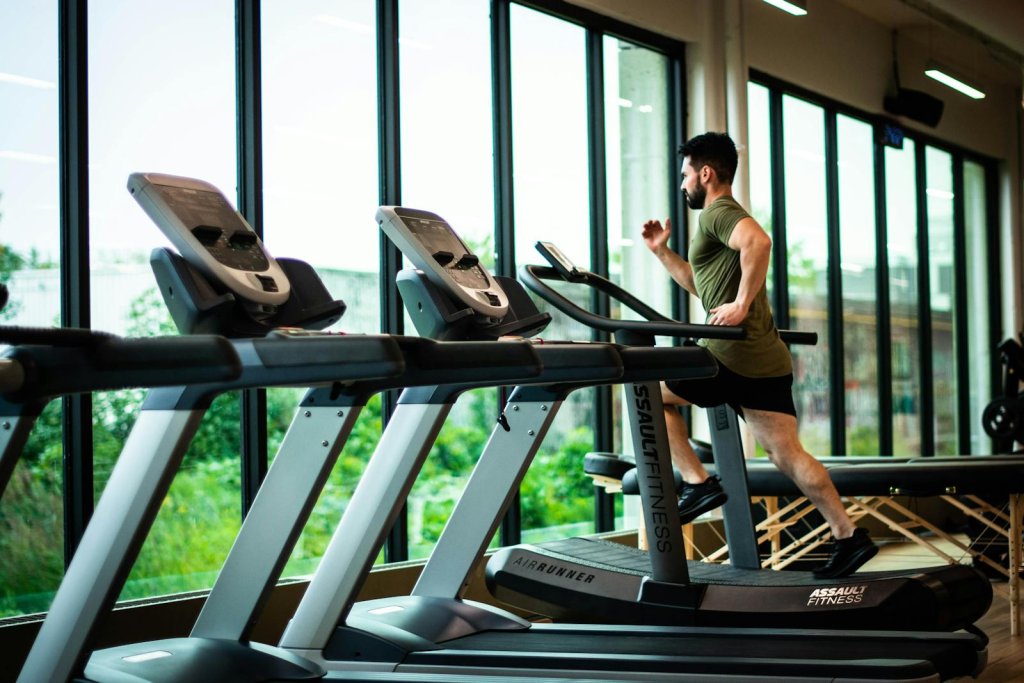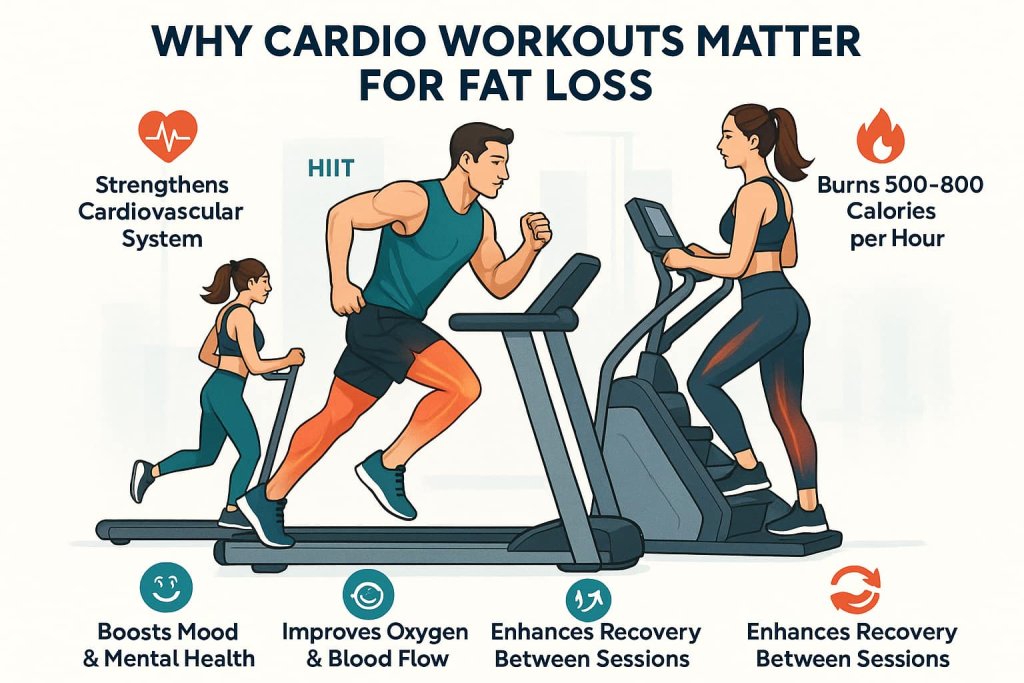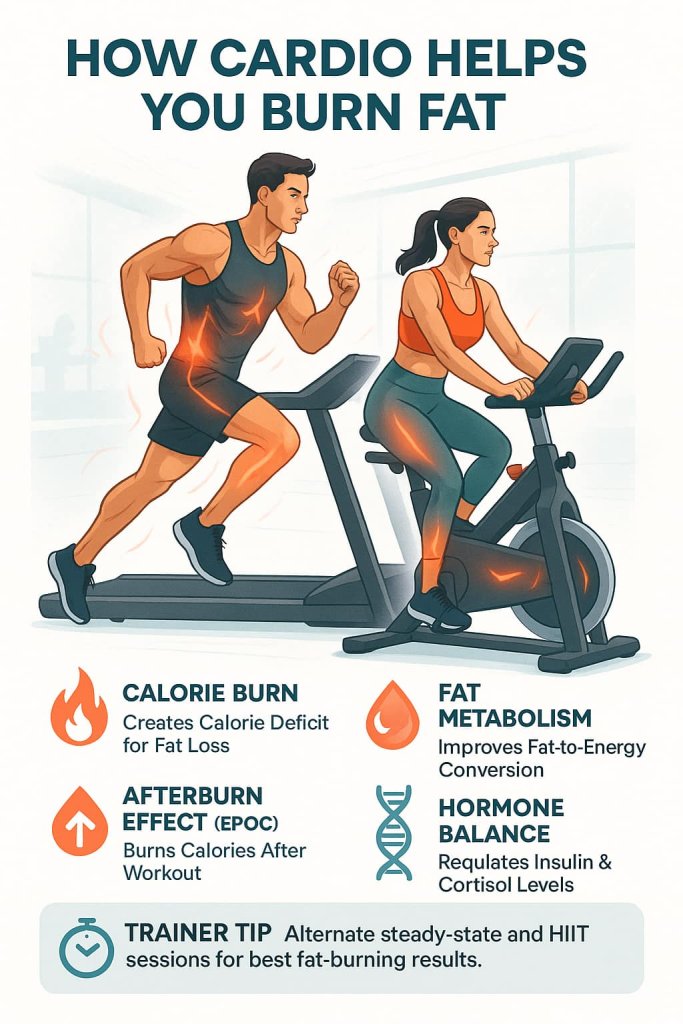Cardio workouts are one of the most effective ways to burn fat fast at the gym — helping you torch calories, improve endurance, and support overall heart health. Whether your goal is to lose weight, boost stamina, or break through a fitness plateau, the right gym-based cardio routine can get you there faster.

Understanding which cardio exercises deliver the best results ensures you make the most of every gym session. Below are the 15 best fat-burning cardio workouts — backed by current research and expert recommendations — to help you train smarter, not longer.
Why Cardio Workouts Matter for Fat Loss
According to Healthline (2024), cardio training increases calorie burn and helps create the caloric deficit needed for fat loss. High-intensity routines like HIIT or stair climbing can burn up to 500–800 calories per hour, while also boosting post-workout metabolism (EPOC).

Beyond weight loss, cardio workouts:
- Strengthen the heart and lungs
- Improve circulation and endurance
- Enhance recovery between strength-training sessions
- Support mental health through endorphin release
For best results, combine cardio with a balanced diet and resistance training.
How Cardio Helps You Burn Fat
Cardio burns fat by increasing your calorie expenditure and improving how efficiently your body uses energy. When your heart rate rises during exercise, oxygen demand increases, and your body taps into stored fat for fuel — especially during longer or moderate-intensity workouts.

1. Boosts Calorie Burn
Cardio creates a calorie deficit — the foundation of fat loss. According to the American Council on Exercise (2024), 30 minutes of moderate cardio burns 300–400 calories, while HIIT can exceed 600.
2. Improves Fat Metabolism
Low- to moderate-intensity cardio uses fat as a primary energy source. Over time, consistent training enhances your body’s ability to convert fat into fuel, raising your overall metabolic rate.
3. Triggers the Afterburn Effect
High-intensity workouts increase EPOC (Excess Post-Exercise Oxygen Consumption) — your body keeps burning calories for hours post-workout.
4. Balances Key Hormones
Cardio helps regulate insulin, cortisol, and adrenaline — hormones that directly influence fat storage and energy use.
Trainer Tip:
Mix steady-state cardio (like cycling or incline walking) with HIIT sessions (like sprints or circuits) for maximum fat-burning efficiency and metabolic health.
The 15 Best Cardio Exercises at the Gym to Burn Fat Fast
1. Treadmill Sprints
Why it works:
Treadmill sprints deliver one of the highest calorie burns per minute in the gym. Short, high-intensity efforts drive your heart rate to near maximum, activating fast-twitch muscle fibers and triggering the afterburn effect (EPOC) — meaning your body continues to burn calories for hours after the workout. This combination of aerobic and anaerobic conditioning enhances fat oxidation and endurance simultaneously.
Muscles worked: Quadriceps, hamstrings, glutes, calves, hip flexors, and core stabilizers.
How to do it:
- Warm up for 5 minutes with brisk walking or a light jog.
- Set the treadmill incline to 1–2% to mimic outdoor terrain.
- Sprint for 30 seconds at 80–90% of your maximum speed.
- Recover by walking or jogging for 60–90 seconds.
- Repeat 8–10 rounds, then cool down for 3–5 minutes.
Trainer Tip:
Keep your core tight, drive with your knees, and look straight ahead. Don’t hold the handrails — allow natural arm movement for balance and rhythm.
2. Stair Climber
Why it works:
The stair climber is a powerhouse for building lower-body strength while torching calories. The continuous stepping motion keeps your heart rate elevated, activating large muscles that demand high oxygen output — a proven formula for fat burning. This machine also helps improve balance, endurance, and leg stability.
Muscles worked: Glutes, quadriceps, hamstrings, calves, hip flexors, and core.
How to do it:
- Start with a slow pace for 2–3 minutes to warm up.
- Gradually increase speed until you find a challenging but sustainable pace.
- Maintain steady stepping for 20–30 minutes.
- For intervals, alternate 1 minute of fast stepping with 1 minute of moderate pace.
Trainer Tip:
Avoid leaning heavily on the handrails — this reduces effectiveness. Keep your posture tall, abs engaged, and steps controlled for full muscle activation.
3. Rowing Machine
Why it works:
Rowing is a total-body cardio workout that combines resistance and aerobic training. It recruits over 85% of your muscles with each stroke, improving power output, cardiovascular endurance, and posture. The combination of pulling, pushing, and core engagement maximizes calorie expenditure in minimal time.
Muscles worked: Legs (quads, hamstrings), back (lats, traps, rhomboids), shoulders, arms, and core.
How to do it:
- Warm up at a slow pace for 3 minutes.
- Row powerfully for 1 minute, maintaining a consistent rhythm.
- Follow with 1 minute of slower recovery rowing.
- Repeat for 20–25 minutes.
Trainer Tip:
Follow the correct sequence: push with your legs → hinge at the hips → pull with your arms. On return, reverse the order. This ensures efficiency and prevents back strain.
4. Elliptical Trainer
Why it works:
The elliptical offers a joint-friendly, full-body cardio workout. Its smooth motion reduces impact stress while maintaining heart rate elevation. It’s ideal for fat loss, endurance training, or recovery days. Adjusting resistance and incline can mimic running or stair climbing without joint wear.
Muscles worked: Glutes, hamstrings, quadriceps, calves, chest, triceps, and core.
How to do it:
- Set resistance at a moderate level for 5 minutes to warm up.
- Alternate 2 minutes at high resistance with 2 minutes at low resistance.
- Continue for 30–40 minutes.
Trainer Tip:
Avoid slouching. Keep your spine tall, shoulders relaxed, and stride evenly. Use the handles actively to engage your upper body for greater calorie burn.
5. Spin Bike (Stationary Cycling)
Why it works:
Indoor cycling is a high-intensity, low-impact calorie crusher. It builds leg endurance and cardiovascular fitness while being gentle on joints. Research shows that cycling at high resistance can burn up to 600–800 calories per hour, depending on intensity.
Muscles worked: Quadriceps, glutes, hamstrings, calves, and core.
How to do it:
- Warm up for 5 minutes at light resistance.
- Cycle 1 minute at heavy resistance (high intensity) followed by 2 minutes at light resistance (recovery).
- Repeat for 30–40 minutes.
Trainer Tip:
Maintain proper seat height (knees slightly bent at the bottom of the pedal stroke). Keep your chest open and core tight to protect your lower back.
6. Battle Ropes
Why it works:
Battle ropes blend cardio with strength training, delivering intense metabolic conditioning. They engage multiple muscle groups simultaneously, enhancing endurance, coordination, and explosive power while rapidly burning fat.
Muscles worked: Shoulders, arms, chest, upper back, core, and legs.
How to do it:
- Grip both ropes with a firm hold, feet shoulder-width apart, knees bent.
- Create alternating waves for 30 seconds.
- Rest for 30 seconds and repeat 10–15 rounds.
Trainer Tip:
Keep your abs braced and move from your hips, not your shoulders. Shorter, quicker waves increase cardiovascular demand.
7. Jump Rope
Why it works:
Jumping rope improves coordination, agility, and cardiovascular fitness. It’s one of the simplest yet most efficient ways to burn calories quickly — up to 15 calories per minute, according to Harvard Health (2024).
Muscles worked: Calves, quads, glutes, shoulders, forearms, and core.
How to do it:
- Jump continuously for 60 seconds, rest for 30 seconds.
- Perform 10–15 rounds.
- Gradually increase speed or double unders as you progress.
Trainer Tip:
Land softly on the balls of your feet and keep your jumps low. Keep elbows close to your body and rotate from the wrists, not the arms.
8. HIIT Circuit
Why it works:
High-Intensity Interval Training (HIIT) pushes your body into an oxygen deficit, forcing it to burn fat during and after the workout. It enhances metabolism, endurance, and athletic performance in less time than traditional cardio.
Muscles worked: Full body — legs, core, shoulders, and chest.
How to do it:
- Perform 30 seconds each of burpees, jump squats, and mountain climbers.
- Rest for 60 seconds.
- Repeat for 4–6 rounds (20–25 minutes total).
Trainer Tip:
Focus on quality reps. Maintain high effort (80–90% of max heart rate) during work intervals for best results.
9. Row-and-Run Combo
Why it works:
Combining rowing and running alternates between pulling and pushing movements — engaging upper and lower body while maintaining constant cardiovascular demand. This hybrid approach rapidly improves VO₂ max and fat oxidation.
Muscles worked: Back, legs, arms, and core.
How to do it:
- Row 500 meters as fast as possible.
- Immediately run 400 meters on the treadmill.
- Rest 1 minute, then repeat for 4–6 rounds.
Trainer Tip:
Track split times for each round and aim to maintain or slightly improve your pace every set.
10. Incline Walking
Why it works:
Walking on an incline elevates heart rate without joint impact. It simulates uphill hiking, strengthening your posterior chain and improving fat metabolism. Ideal for beginners or active recovery.
Muscles worked: Glutes, hamstrings, calves, and core.
How to do it:
- Set treadmill incline to 10–15% and walk at 3–4 mph for 30–45 minutes.
- Focus on steady breathing and posture.
Trainer Tip:
Swing your arms naturally and avoid leaning forward. For progression, increase incline before speed.
11. Air Bike (Assault Bike)
Why it works:
The air bike uses wind resistance to automatically adjust to your effort. It’s brutal yet efficient — combining upper and lower body movement for unmatched calorie burn in short time.
Muscles worked: Legs, chest, shoulders, arms, and core.
How to do it:
- Sprint for 20 seconds at maximum effort.
- Recover at slow pace for 40 seconds.
- Repeat for 10–12 rounds.
Trainer Tip:
Focus on powerful, even pushes and pulls. Maintain a smooth rhythm rather than jerky movements for endurance and control.
12. Kickboxing
Why it works:
Kickboxing blends aerobic conditioning with explosive strength and coordination. It’s excellent for full-body fat burning, improving agility, balance, and mental focus while reducing stress.
Muscles worked: Shoulders, arms, chest, glutes, hamstrings, core, and hips.
How to do it:
- Perform 3-minute rounds of punch and kick combinations.
- Rest 1 minute between rounds.
- Complete 6–8 rounds total.
Trainer Tip:
Focus on technique — pivot your hips for power. Keep your core engaged for stability and to protect your lower back.
13. VersaClimber
Why it works:
A vertical climbing workout that activates both upper and lower body simultaneously, challenging your cardiovascular system and muscles under resistance. It burns up to 800 calories per hour, making it one of the most efficient fat-burning machines.
Muscles worked: Glutes, quads, calves, shoulders, biceps, triceps, and core.
How to do it:
- Begin with a light climb for 2 minutes.
- Perform 30 seconds all-out effort, then 1 minute easy pace.
- Repeat for 15–20 minutes.
Trainer Tip:
Keep your chest close to the handles and move with long, controlled strides for better range of motion.
14. Swimming (Indoor Pool)
Why it works:
Swimming offers full-body resistance while being extremely low-impact. It boosts cardiovascular endurance, tones muscles, and improves lung capacity. Water resistance increases calorie burn while cushioning joints.
Muscles worked: Lats, deltoids, triceps, legs, glutes, and core.
How to do it:
- Swim alternating laps of freestyle and breaststroke for 30–40 minutes.
- Maintain steady breathing rhythm.
- For intervals: swim 2 fast laps, 1 easy lap recovery.
Trainer Tip:
Focus on controlled breathing — exhale underwater, inhale as you turn your head. Proper breathing improves oxygen efficiency and endurance.
15. Circuit Training
Why it works:
Circuit training merges strength and cardio into one efficient routine, boosting calorie expenditure and muscle tone. Moving quickly between exercises maintains heart rate, building both aerobic capacity and lean muscle simultaneously.
Muscles worked: Full body — legs, chest, arms, shoulders, and core (depending on exercise selection).
How to do it:
- Choose 6–8 stations (e.g., jump squats, push-ups, kettlebell swings, burpees, planks).
- Perform each move for 40 seconds, rest 20 seconds.
- Complete 3–4 full circuits.
Trainer Tip:
Keep transitions under 15 seconds to maintain intensity. Track rounds weekly to measure endurance and progression.
How to Structure Your Gym Cardio Routine
| Goal | Frequency | Duration | Intensity |
|---|---|---|---|
| Fat Loss | 4–5 sessions/week | 30–45 mins | Moderate to High |
| Endurance | 3–4 sessions/week | 45–60 mins | Moderate |
| Heart Health | 3 sessions/week | 30 mins | Moderate |
Trainer Tip: Combine 2 HIIT days + 3 steady-state days weekly for optimal fat-burning and recovery.
Safety Tips Before Starting Cardio Workouts
- Warm up for 5–10 minutes with light dynamic stretches.
- Stay hydrated and maintain proper form.
- Avoid overtraining — rest 48 hours between intense sessions.
- Wear proper shoes to reduce impact on knees and ankles.
- Consult a professional if you have heart, knee, or joint issues.
Frequently Asked Questions (FAQ)
1. What’s the best time for cardio — morning or evening?
Morning cardio can help boost metabolism early, but evening sessions may improve endurance. Choose what fits your schedule best.
2. How long should a gym cardio session last?
For fat loss, aim for 30–45 minutes of moderate to high-intensity cardio.
3. Can I do cardio every day?
Yes, but vary the intensity — alternate between high, moderate, and recovery days.
4. Should I do cardio before or after weights?
If your goal is fat loss, do cardio after weights; if endurance, do it before.
5. Which cardio burns the most fat?
HIIT, stair climbing, and rowing top the list for calorie and fat burn efficiency.
6. How do I prevent muscle loss during cardio?
Pair cardio with strength training and eat sufficient protein (1.6–2.2 g/kg of body weight).
7. How soon will I see results?
With consistent effort and proper nutrition, noticeable fat loss can appear in 4–6 weeks.
Conclusion
The best cardio workouts at the gym aren’t about endless hours on the treadmill — they’re about smart variety and intensity. Combining HIIT, steady-state, and full-body movements keeps workouts exciting and results-driven.
Start with 3–4 cardio sessions per week, focus on progression, and stay consistent. Your heart, stamina, and waistline will thank you.
References
- Health (2025): “Exercises that can burn more calories than running.” Recent media roundup with trainer input; useful for HIIT, jumping rope, rowing, swimming, kickboxing, circuits calorie ranges (attribute carefully as media).
- American Heart Association – Physical Activity Recommendations for Adults (Jan 19, 2024). Current guideline: 150 min/week moderate or 75 min/week vigorous aerobic activity, plus strength work 2+ days/week.
- American College of Sports Medicine – Physical Activity Guidelines (ACSM x CDC). Summary of adult aerobic & muscle-strengthening recommendations.
- Nature Scientific Reports (2024): “Acute interval running induces greater excess post-exercise oxygen consumption (EPOC)…” HIIT produced greater total energy expenditure and EPOC than energy-matched moderate training.
